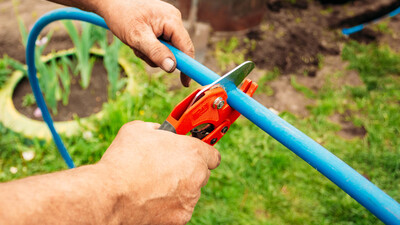Plastic pipes are a staple in plumbing, irrigation and industrial applications due to their durability and flexibility. However, joining these pipes requires specific techniques tailored to each type. This guide covers the methods for connecting plastic pipes, including ring seal, solvent weld, compression, electrofusion and twinwall pipes.
Ring Seal Joints
Ring seal joints, also known as push-fit joints, are popular in domestic plumbing, particularly for waste and drainage pipes.
Assembling a ring seal joint
To join ring seal pipes, start by ensuring the pipe ends are cut square and are free from burrs. It’s important to clean the pipe ends to remove any debris. Apply a small amount of silicone-based lubricant to the ring seal inside the fitting. Then, push the pipe into the fitting until it reaches the stop, using a slight twisting motion. Make sure there are no gaps between the pipe and the fitting to ensure a secure seal.
Solvent Weld Joints
Solvent welding chemically bonds PVC and ABS pipes, creating a strong, permanent connection.
Creating a solvent weld joint
First, cut the pipe to the desired length and chamfer the edges to avoid damaging the fitting. Clean the pipe and fitting with a cloth. Apply a primer to both the pipe end and the inside of the fitting to clean and soften the surfaces for better adhesion. Next, spread an even layer of solvent cement on the primed areas. Quickly insert the pipe into the fitting with a slight twist to ensure an even distribution of cement, and hold the joint in place for a few seconds. Allow the joint to cure according to the manufacturer’s instructions before pressurising the system.
Compression Fittings
Compression fittings are versatile and suitable for various plastic pipes, including PEX and PE.
Assembling a compression joint
To join compression fittings, cut the pipe squarely and remove any burrs. Slide the compression nut and ring (olive) onto the pipe. Push the pipe fully into the fitting body and hand-tighten the compression nut. Use a wrench to tighten it further, but be careful not to overtighten it, as this can damage the fitting or pipe. After tightening, check the joint for leaks by pressurising the system.
Electrofusion Joints
Electrofusion is used for joining polyethylene pipes, especially in gas and water supply systems.
Creating an electrofusion joint
Begin by cutting the pipe square and scraping the outer surface to remove the oxidation layer. Clean the pipe and fitting using a recommended cleaning solution to remove contaminants. Insert the pipe ends into the electrofusion fitting. Attach the electrofusion leads to the fitting and follow the machine’s instructions to start the fusion process. The heating elements inside the fitting will melt the pipe surface, creating a strong bond. Let the joint cool and solidify before handling or pressurising.
Twinwall Ducting and Twinwall Drainage Pipes
Twinwall ducting and drainage pipes are commonly used for electrical and drainage systems. Most twinwall ducting products come with a pre-attached coupler.
Joining twinwall pipes
Ensure each pipe has a pre-attached coupler before starting. If you need to connect another length of twinwall ducting, simply push the coupler onto the next pipe. Since the coupler doesn’t have an internal seal, you might experience minor leakage. If you’re channelling surface water, this might not be a problem. However, if you’re carrying waste or a solvent with chemical components, you’ll need to seal this connection. Select the appropriate size of the twinwall pipe seal and place it between the first and second twinwall pipe ribs that will enter each end of the coupler. The coupler will now require a bit more effort to locate correctly over the twinwall pipes, but it will be watertight.
For systems carrying solvents or corrosive materials, consider nitrile seals. These are made to order and subject to lead times. Consulting with a technical team based on soil reports and specific requirements can be beneficial.
We hope you have found this information interesting and helpful. If you have any further questions you are always welcome to call our friendly team of experts on 01420 555600 or email [email protected].
Also, look out for more articles in our ongoing series of blog posts, bringing you useful information, insights, guides and tips on all things drainage!

Written by
Bob Stone
Technical Sales
Heading up our Technical Estimating Department, Bob is our in-house quantity surveyor.

